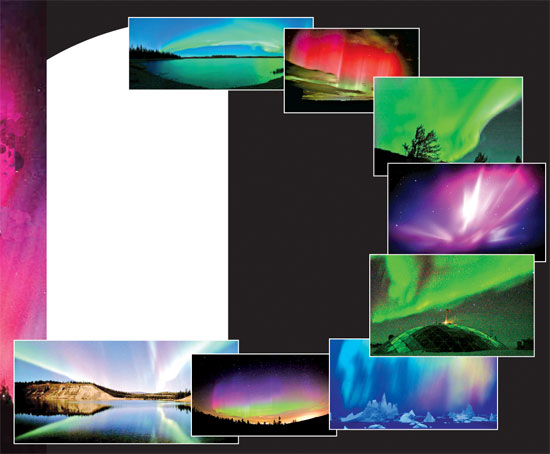Mystic lights...
Aururas dance in the night
sky:
You may think that the spectacular pictures here are those of a
fireworks display held to usher in the New Year which dawned just
yesterday, but they are not.The vibrant hues that light up the night sky
have nothing to do with fireworks because they are the famous auroras or
the northern or southern lights which occur as a natural phenomenon.
Let's check out how these lights light up the sky just in case you are
not familiar with them ....
First we need to know what an aurora is. An aurora is a natural
display of light in the sky that can be seen without the aid of a
telescope,that means, the naked eye or the unaided eye. However, an
aurora can be seen only at night.

An auroral display in the Northern Hemisphere is called the Aurora
borealis, or the Northern Lights while a similar display in the Southern
Hemisphere is called the Aurora Australis or the Southern Lights .
These auroras which are known to be simply awesome to watch are the
most visible effect of the sun's activity on the Earth's atmosphere.
Most of these auroras generally occur in far northern and southern
regions. They appear mainly as arcs, clouds, and streaks. According to
scientists some of these spectacular auroras either move, brighten up,
or flicker suddenly.
When you look at the beautiful pictures of the auroras featured here
you will be able to note that they come in many vibrant hues. The most
common colour in an aurora is green. Scientists claim that displays that
occur extremely high in the sky could be either red or purple.But
auroras do not make their appearance just anywhere on the Earth, even in
the regions they generally occur. Most auroras occur about 60 to 620
miles (97 to 1,000 kilometres) above the Earth. Some even extend
lengthwise across the sky for thousands of miles or kilometres.
Auroral displays are associated with the solar wind, a continuous
flow of electrically charged particles from the Sun. When these
particles reach the Earth's magnetic field, some get trapped. Many of
these particles travel towards the Earth's magnetic poles. When the
charged particles strike atoms and molecules in the atmosphere, energy
is released. Some of this energy appears in the form of Auroras. Auroras
occur most frequently during the most intense phase of the 11-year
sunspot cycle. During this phase, dark patches on the Sun's surface,
called sunspots, increase in number. Violent eruptions on the Sun's
surface, known as solar flares, are associated with sunspots.
Electrons and protons released by solar flares add to the number of
solar particles that interact with the Earth's atmosphere. This
increased interaction produces extremely bright auroras. It also results
in sharp variations in the Earth's magnetic field called magnetic
storms. During these storms, auroras may shift from the polar regions
toward the equator.
How do auroras form?
Essentially, the light of auroras is emitted when charged particles
in the solar wind excite the electrons of atmospheric atoms through
collisions. As the electrons return to their original energy levels,
these atoms, primarily oxygen and nitrogen, emit photons of visible
light of distinct wavelengths to create the colours of the auroral
display. The wavelength of the light depends upon the electronic
structure of the atoms or molecules themselves, and on the energy of the
charged particle colliding with the atom or molecule.
**********
FAST FACTS
*During the luminous phenomenon of an aurora, streams of colourful
light appear as reds, greens, yellows, pinks, and purples.
* Auroras occur on other planets too. Auroras have been observed on
Jupiter and Saturn which have magnetic fields much stronger than the
Earth's.
* Auroras have been observed even on Venus and Mars. However, as
Venus has no planetary magnetic field auroras appears as bright and
widely spread patches of varying shapes and intensity
* The best aurora viewing time in the Arctic is during the Northern
Hemisphere's winter, and in the Antarctic during the Southern
Hemisphere's winter, when long, dark nights provide the best conditions.
This is not because the auroras are seasonal" in fact, satellite
pictures reveal that auroras occur simultaneously in the two polar
regions of the magnetosphere.
* The Aurora Borealis and the Aurora Australis share many
characteristics. The small differences between them depend on which pole
is oriented towards the solar wind, and may also reveal irregularities
in the Earth's magnetic field.
* The spring and summer equinoxes have been identified as another
period of intense auroral activity. Scientists speculate that these two
related points in Earth's orbit of the Sun favour the interaction of the
magnetic activity between the two bodies.
* An aurora was detected on Mars on August 14, 2004 by the SPICAM
instrument aboard the Mars Express.
* Images of auroras are common today due to the use of digital
cameras that have high sensitivities.
* In ancient Roman mythology, Aurora is the goddess of the dawn, who
renews herself every morning to fly across the sky, announcing the
arrival of the Sun.
* An image of an aurora was used as part of the emblem for the 1994
Winter Olympics held in Lillehammer.
* Northern lights are named after the Roman goddess Aurora and the
Greek name for the north wind Boreas.
*Australis is the Latin word for 'of the South'
* Aurora australis can be seen only from high southern latitudes in
Antarctica, South America or Australasia.
********** |

